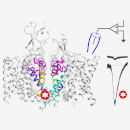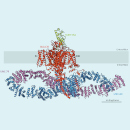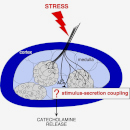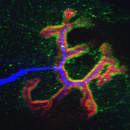The excitability of neurons, endocrine cells and muscle cells greatly depends on the ion channels studied by the team. While electrophysiology, in particular the patch-clamp technique, is favored for studying these ion channels, it is the complementarity of the diverse approaches and models we use in the lab (molecular and cellular biology, biochemistry, immuno-cytochemistry, animal and cellular models, etc.) that enables us to study as effectively as possible i) the intrinsic properties of ion channels, ii) their physiological roles, iii) their involvement in diseases. The team’s work on Cav3 calcium channels, Nav1.4 sodium channels and NALCN channels can be best appreciated through the reading of several review articles recently published by the team members, listed below:
- Lory P, Nicole S, Monteil A. Neuronal Cav3 channelopathies: recent progress and perspectives. Pflugers Arch. 2020 472(7):831-844. PMID: 32638069.
- Nicole S, Lory P. New Challenges Resulting From the Loss of Function of Nav1.4 in Neuromuscular Diseases. Front Pharmacol. 2021 12:751095. PMID: 34671263.
- Guérineau NC, Monteil A, Lory P. Sodium background currents in endocrine/neuroendocrine cells: Towards unraveling channel identity and contribution in hormone secretion. Front Neuroendocrinol. 2021 63:100947. PMID: 34592201.
- Monteil A, Guérineau NC, Gil-Nagel A, Parra-Diaz P, Lory P, Senatore A. New insights into the physiology and pathophysiology of the atypical sodium leak channel NALCN. Physiol Rev. 2024 104(1):399-472. PMID: 37615954.
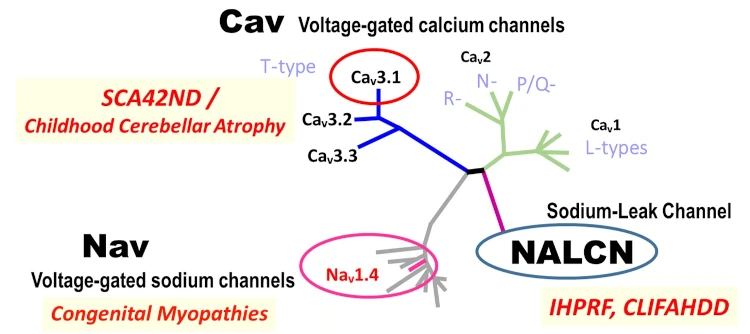
The genetic homology between the ion channels studied by the team and associated pathologies.
Team leader

DR1, CNRS

IGF Sud 129

04 34 35 92 50
Know more >
Researchers

DR1, CNRS

IGF Sud 129

04 34 35 92 50
Know more >

CRHC, CNRS

IGF Sud 129

04 34 35 92 50
Know more >

CRHC, Inserm

IGF Sud 129

04 34 35 92 50
Know more >

Accueil scientifique, CNRS

IGF Sud 103

04 34 35 92 52
Know more >
Technicians and engineers

IECN, CNRS

IGF Sud 129

04 34 35 92 50
Know more >
Postdoctoral researchers and doctoral students

Doctorant(e), UM

IGF Sud 103

04 34 35 92 52
Know more >

Doctorant(e), UM

IGF Sud 129

04 34 35 92 50
Know more >
Fixed term contract technicians and engineers

IE CDD, Inserm

IGF Sud 129

04 34 35 92 51
Know more >

IE CDD, Inserm

IGF Sud 129

04 34 35 92 51
Know more >

AI CDD, CNRS

IGF Sud 103

04 34 35 92 52
Know more >
Trainees

Master 2, CNRS

IGF Sud 129

04 34 35 92 50
Know more >

Master 1, Inserm

IGF Sud 129

04 34 35 92 50
Know more >
- Monteil A, Guérineau NC, Gil-Nagel A, Parra-Diaz P, Lory P, Senatore A. New insights into the physiology and pathophysiology of the atypical sodium leak channel NALCN. Physiol Rev. 2024 Jan 1;104(1):399-472. doi: 10.1152/physrev.00014.2022. Epub 2023 Aug 24. PMID: 37615954.
- Nicole S, Lory P. New Challenges Resulting From the Loss of Function of Nav1.4 in Neuromuscular Diseases. Front Pharmacol. 2021 Oct 4;12:751095. doi: 10.3389/fphar.2021.751095. PMID: 34671263; PMCID: PMC8521073.
- Impheng H, Lemmers C, Bouasse M, Legros C, Pakaprot N, Guérineau NC, Lory P, Monteil A. The sodium leak channel NALCN regulates cell excitability of pituitary endocrine cells. FASEB J. 2021 May;35(5):e21400. doi: 10.1096/fj.202000841RR. PMID: 33793981.
- Guérineau NC, Monteil A, Lory P. Sodium background currents in endocrine/neuroendocrine cells: Towards unraveling channel identity and contribution in hormone secretion. Front Neuroendocrinol. 2021 Oct;63:100947. doi: 10.1016/j.yfrne.2021.100947. Epub 2021 Sep 27. PMID: 34592201.
- Milman A, Ventéo S, Bossu JL, Fontanaud P, Monteil A, Lory P, Guérineau NC. A sodium background conductance controls the spiking pattern of mouse adrenal chromaffin cells in situ. J Physiol. 2021 Mar;599(6):1855-1883. doi: 10.1113/JP281044. Epub 2021 Jan 29. PMID: 33450050; PMCID: PMC7986707.
- Lory P, Nicole S, Monteil A. Neuronal Cav3 channelopathies: recent progress and perspectives. Pflugers Arch. 2020 Jul;472(7):831-844. doi: 10.1007/s00424-020-02429-7. Epub 2020 Jul 7. PMID: 32638069; PMCID: PMC7351805.
- Bouasse M, Impheng H, Servant Z, Lory P, Monteil A. Functional expression of CLIFAHDD and IHPRF pathogenic variants of the NALCN channel in neuronal cells reveals both gain- and loss-of-function properties. Sci Rep. 2019 Aug 13;9(1):11791. doi: 10.1038/s41598-019-48071-x. PMID: 31409833; PMCID: PMC6692409.
- Chemin J, Siquier-Pernet K, Nicouleau M, Barcia G, Ahmad A, Medina-Cano D, Hanein S, Altin N, Hubert L, Bole-Feysot C, Fourage C, Nitschké P, Thevenon J, Rio M, Blanc P, Vidal C, Bahi-Buisson N, Desguerre I, Munnich A, Lyonnet S, Boddaert N, Fassi E, Shinawi M, Zimmerman H, Amiel J, Faivre L, Colleaux L, Lory P, Cantagrel V. De novo mutation screening in childhood-onset cerebellar atrophy identifies gain-of-function mutations in the CACNA1G calcium channel gene. 2018 Jul 1;141(7):1998-2013. doi: 10.1093/brain/awy145. PMID: 29878067.
- Coutelier M, Blesneac I, Monteil A, Monin ML, Ando K, Mundwiller E, Brusco A, Le Ber I, Anheim M, Castrioto A, Duyckaerts C, Brice A, Durr A, Lory P, Stevanin G. A Recurrent Mutation in CACNA1G Alters Cav3.1 T-Type Calcium-Channel Conduction and Causes Autosomal-Dominant Cerebellar Ataxia. Am J Hum Genet. 2015 Nov 5;97(5):726-37. doi: 10.1016/j.ajhg.2015.09.007. Epub 2015 Oct 8. PMID: 26456284; PMCID: PMC4667105.
- Cochet-Bissuel M, Lory P, Monteil A. The sodium leak channel, NALCN, in health and disease. Front Cell Neurosci. 2014 May 20;8:132. doi: 10.3389/fncel.2014.00132. PMID: 24904279; PMCID: PMC4033012.

Deciphering the role of calcium channels in neurodevelopemental diseases
Principal investigator
Philippe LORY
Find out more
NALCN channels in physiology and diseases
Principal investigator
Arnaud MONTEIL
Find out more
Stimulus-secretion coupling in the adrenal medullary tissue: pathophysiology of the adaptive response to stress and associated disorders
Principal investigator
Nathalie GUERINEAU
Find out more
Therapeutics of muscle weakness related to the sodium channel Nav1.4
Principal investigator
Sophie NICOLE
Find out more
TECHNOLOGIES
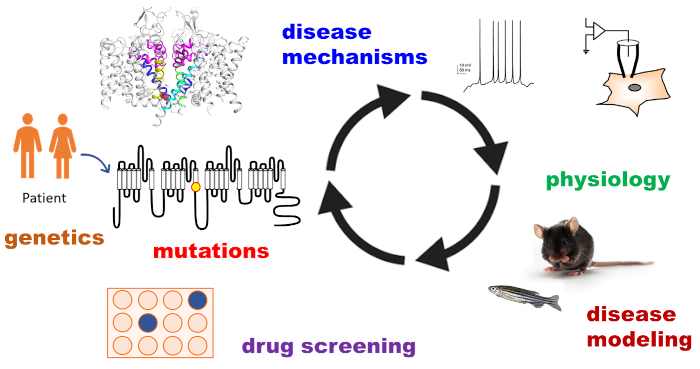
The schematic « ion channel toolkit » used in the team to encover the role of ion channels in physiology and diseases.
FUNDING
• FMR (Fondation Maladies Rares) “High throughput screening” grant (2024-2026)
• ANR PRC ‘CaCh-Investigation’ project (2023-2027)
• LabEx ICST ‘Ion Channels Science & Therapeutics’, partner and scientific council (2012-2024)
• AFM Telethon “ActNavLOF” project (2023-2024)
• Fondation CSC (Connaitre les Syndromes Cérébelleux), grant (2023-2024)
• ERA-NET NEURON ‘Neurodevelopmental Disorders’, projet RestoreLeak (2022-2025)
• FMR (Fondation Maladies Rares) “High throughput screening” grant (2022-2023)
• FRC (Fédération pour la Recherche sur le Cerveau), EET (2022)
• ANR PRCE ‘NeuroCard’ project (2022-2025)
• Hubert Curien Siam exchange program (2020-2021)
• Equipe FRM (Fondation Recherche Médicale) grant (2017-2020)
• FMR (Fondation Maladies Rares) “animal models” grant (2019-2020)
• AFM Telethon (2018-2020)
• PHENOMIN appel d’offre 2020 ‘modèle animal’ (2020)
• PRC CNRS – University of Toronto exchange program (2018)

Team members
From left to right (permanent staff in bold): Sophie Nicole, Claire Bernat, Zoe Servant, Nathalie Guérineau, Hathaichanok Impheng, Arnaud Monteil, Auemphon Mordmuang, Philippe Lory, Clément Marchal, Amaël Davakan.
ALUMNI
Past contributors to the team’s work:
Postdoctoral fellows
Lidiane Pereira Garcia (2022-2023)
Maud Cochet (2012-2015)
Iulia Blesneac (2011-2015)
PhD students
Hathaichanok Impheng (2016-2020)
Alexandre Milman (2015-2018)
Malik Bouasse (2014-2017)
Tiphaine Voisin (2012-2016)
Technician – Engineers
Zoé Servant (2018-2020)
Andie Godo (2016-2017)
Master students
Sujira Chedsadavitayakul (2023)
Marion Chevallier (2023)
Romain Baudat (2022)
Youssef Issa (2022)
Julien Grelaud (2021)
Adrien Lesage (2019)



 IGF Sud 129
IGF Sud 129 04 34 35 92 50
04 34 35 92 50
 IGF Sud 129
IGF Sud 129 04 34 35 92 50
04 34 35 92 50
 IGF Sud 129
IGF Sud 129 04 34 35 92 50
04 34 35 92 50
 IGF Sud 129
IGF Sud 129 04 34 35 92 50
04 34 35 92 50
 IGF Sud 103
IGF Sud 103 04 34 35 92 52
04 34 35 92 52
 IGF Sud 129
IGF Sud 129 04 34 35 92 50
04 34 35 92 50
 IGF Sud 103
IGF Sud 103 04 34 35 92 52
04 34 35 92 52
 IGF Sud 129
IGF Sud 129 04 34 35 92 50
04 34 35 92 50
 IGF Sud 129
IGF Sud 129 04 34 35 92 51
04 34 35 92 51
 IGF Sud 129
IGF Sud 129 04 34 35 92 51
04 34 35 92 51
 IGF Sud 103
IGF Sud 103 04 34 35 92 52
04 34 35 92 52
 IGF Sud 129
IGF Sud 129 04 34 35 92 50
04 34 35 92 50
 IGF Sud 129
IGF Sud 129 04 34 35 92 50
04 34 35 92 50